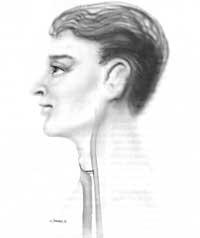Human voice
1996/04/01 Saitua Iribar, Nerea Iturria: Elhuyar aldizkaria
Human beings articulate sounds thanks to the unique structure of the human mouth and its mobility. Thus, sounds become words and songs. The lips and tongue are the last engines of the process and the current of air that reaches the head from the diaphragm of inspiration or inspiration that we have in the abdomen.

Although its name indicates otherwise, the vocal cords are not authentic, but ligaments stuck in the inner wings of the larynx. They are folded together to attach the large thyroid cartilage to the small aritenoid cartilage. The space between the vocal cords is called glottis. During the inspiration the whole structure remains open and when the sound emission or fonation occurs it closes by joining the vocal cords (see figure 1).
In order to emit the sound it is necessary to create a sound vibration that is obtained when the air we extract passes through the vocal cords. In the next step, this sound will be supplied in the resonant cavities with the tibrian characteristics of the voice and finally the process of pronunciation of words.
The sound system consists of three main parts, as well as some air instruments:
- Sponsorship or founder of the breath: respiratory system
- Vibration system: larynx
- Resonance system: adrenal cavities
Respiratory system
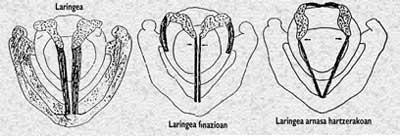
Human breathing is divided into two main phases: breathing and expulsion. In order for the respiratory process to begin, the brain respiratory centers give orders to the muscles that will open the chest, mainly the diaphragm and the external intercostals. By extending the lungs with the chest, the volume increases and the internal pressure decreases. The negative pressure generated in the lungs will cause the ingestion of the outside air inward
The respiratory expulsion process starts passively when the internal pressure of the chest is higher than the atmospheric pressure, thanks to the flexibility of the lung tissue. The ribs descend while the diaphragm ascends and in this movement the internal abdominal and intercostal muscles favor.
Therefore, the flexible physiology of the lung itself allows us to understand that the stable rhythm of relaxed breathing is similar to the duration of each cycle. When we breathe this way, the process is automatically renewed and does not require voluntary control, since the respiratory centers direct everything according to the concentration of oxygen and carbon dioxide. The most appropriate breathing is done by nostrils, since the air captured is heated, moistened and filtered.
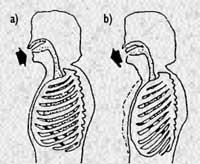
The respiratory mechanism obtained by the flank and diaphragm allows obtaining the highest volume of air in the lungs and serves as a support to the air column that is expelled. The play that is generated between the inspirational and ejector muscles can vary the pressure values under the glottis as desired. At the fonation the respiratory rhythm loses its regularity: breathing is short and deep and breathing becomes a solid expiratory. This process is active and we can modify it voluntarily.
Pressure under Glotis is a source of energy to produce the vibrant vocal cords. Once this pressure is created, its intensity must be regulated according to the voice needs. If the intensity and tone of the sound are desired to be equal, the pressure must be stable and uniform. However, if you have managed to change the inflections of the voice, you will have to change the pressure.
The control of respiratory and expiratory mechanisms leads the speaker to control the pressure under the glottis. This allows an intensity and, in part, a certain ability to regulate the tone.
Vibration system
The larynx is a cartilage skeleton with membranes, muscles, and ligaments. All of them will provide the air source with a vibration element. By opening the vocal cords, the air enters the respiratory system and when closed it behaves as a vibration element. In order to do all this, the voice strings must be mobile. This mobility is achieved through the aritenoid cartilage propelled by the basic muscles of the larynx, which are the ones that generate the movements of rotation and tilting.
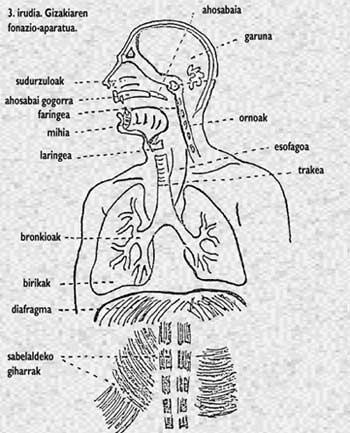
One of the biggest experts in the physiology of the vibration system is the Japanese doctor Hirano. Hirano stressed that in the structure of the vocal cord there are 5 layers of different tissues. His research showed that mechanically the bodies and surfaces of the vocal cord are of different flexibility, so the vibration of the muscle is done horizontally, while the mucosa, with more flexibility and by itself, its movement will be vertical.
Resonance system
If the resonant structures that accompany him did not increase, the fonation in glottis would be very weak. Resonators are cavities that traverse the sounds of the larynx before reaching the outside. They are the parts of our body that vibrate when they come into contact with sound. Among the upper chambers of the glottis are, on the one hand, the hypopharynx or pharyngolaryngeal, on the other, the orophigeal, which groups the oral cavity, the tongue, the teeth and the soft palate and, finally, the nostrils and the cavún of the rinopharynx.
Laryngeal sound is a complex structure, formed by fundamental frequency and harmonic waves. Flexible bodies, like vocal cords, emit many waves when they vibrate, because, in addition to vibrating the entire length, all the parts that form this unit give basic frequencies and secondary waves. That is, each flexible body has its own resonance frequency. Therefore, when a sound of the same frequency arrives it will begin to vibrate by increasing that sound. If the vibration that comes to you does not match your frequency, it will work as a filter, absorbing the sound.
The upper cavities of the larynx act as filters and resonators and must modify the harmonics of the laryngeal sound, reinforcing some (broadening) and decreasing others. The result of the process will be the voice, the modification of the vocal sound.
The size and total shape of the resonant cavities directly affect the resonance of the laryngeal sound. When talking, resonators are always changing their appearance, helping to emit the desired sounds. These resonators, always within a limit, can be modified voluntarily, since they are formed by organs that can move anatomically: tongue, gag, soft palate, external muscles of the larynx and face. On them the nerves exert a motor effect, the hard palate and the nasal holes are stable.
In the resonators are obtained the tymbrian peculiarities of the voice, which characterizes each of them and the characteristics that cause their differentiation. Photophotographic techniques are used for separation and learning.
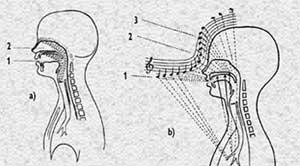
Voice characteristics
Tone
Tone is the number of vibrations per second in which a sound is emitted and regulated by string tension and by length changes. Short and very stretched vocal cords create high tones. For example, children's larynx is in a very high position at birth, which will cause loud or sharp sounds.
Long, unstretched vocal cords will create low tones. Men, because of the hormonal changes they suffer in adolescence, cause the larynx to descend and the strings to be longer, will emit deeper sounds. Women will also be replaced by the larynx, but to a lesser extent and as a result, the tone of the sound will be reduced very little. The same thing happened with the castrates, which were stained before the hormonal change occurred, since the larynx, like the other organs, remained unchanged.

When very demanding records are desired (when the number of vibrations is high) one must also take into account the influence of resonant cavities, as well as changes under glottis can alter the tone size. The set of sounds that the larynx can make is called diffusion.
Intensity
The decibel is used to measure the amount of sound. The intensity of the voice will depend on the power of air that is ejected (pressure under the glottis) and the amplitude of vibration that occurs in the vocal cords. As the subgothic pressure increases against strict glottis, the amplitude of the vibration increases and with it the intensity.
Doorbell
The bell is a characteristic that allows to differentiate two sounds of equal height and intensity. The upper cavities of the larynx, by adopting a different form, will produce different timbres, since they alter the quantity, intensity and distribution of the harmonic set that emits the larynx.
The voice cycle begins at the bottom of the vocal cords. Therefore, the lower part of the vocal cord begins to open and to wound before the top. The frequency of this event is the fonation frequency. When the strings are strict, the mucosa has a wavy movement that opens and tightens the glottis and varies according to the sound emitted. This movement is joined in vibrant cycles. The Hertz unit (cycle/second) is used to measure the tone. When this vibrating complex changes there is a dysphonia or a change of voice timbre. |

Gai honi buruzko eduki gehiago
Elhuyarrek garatutako teknologia




